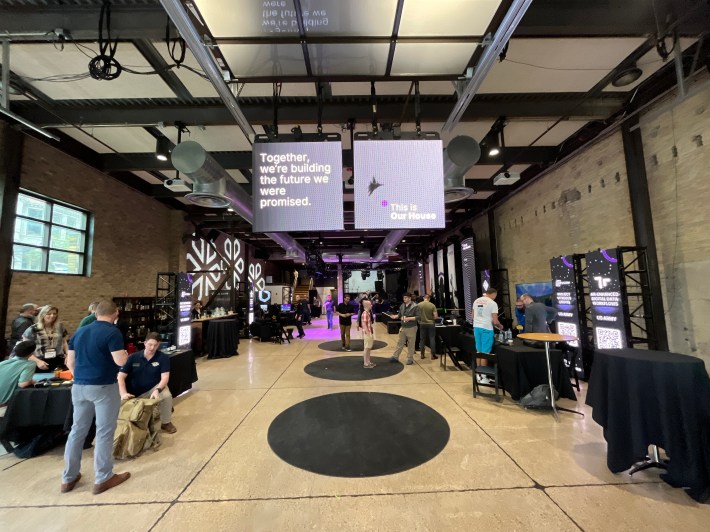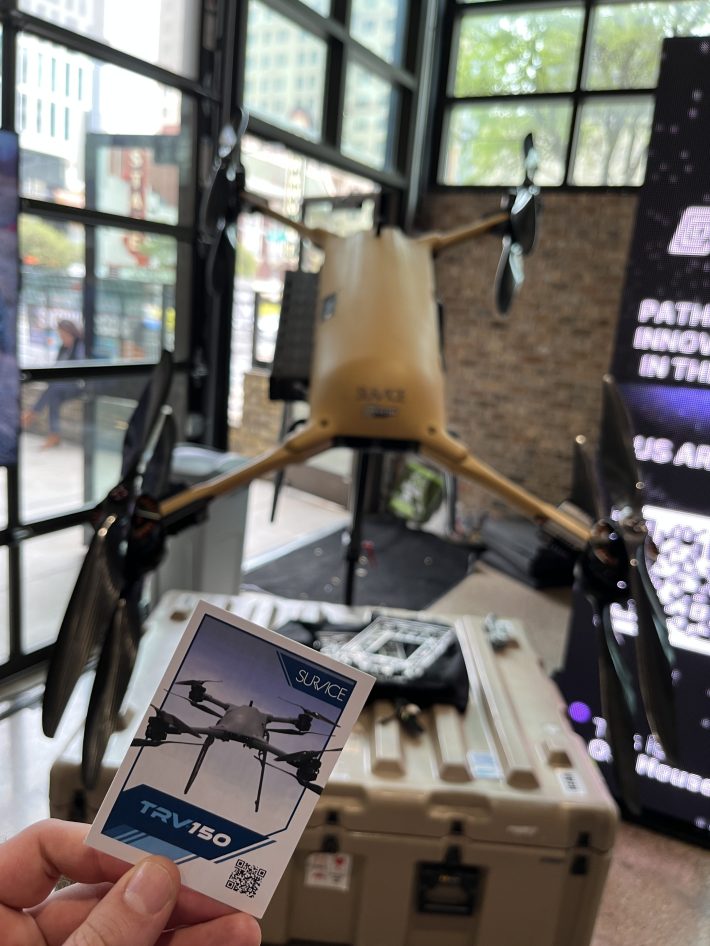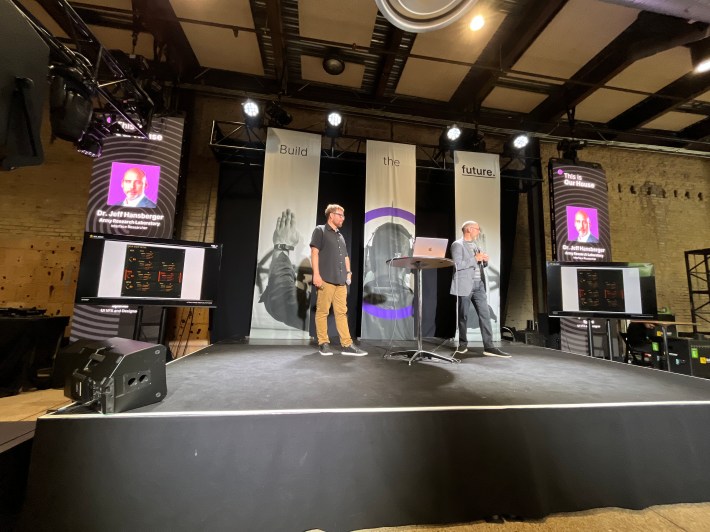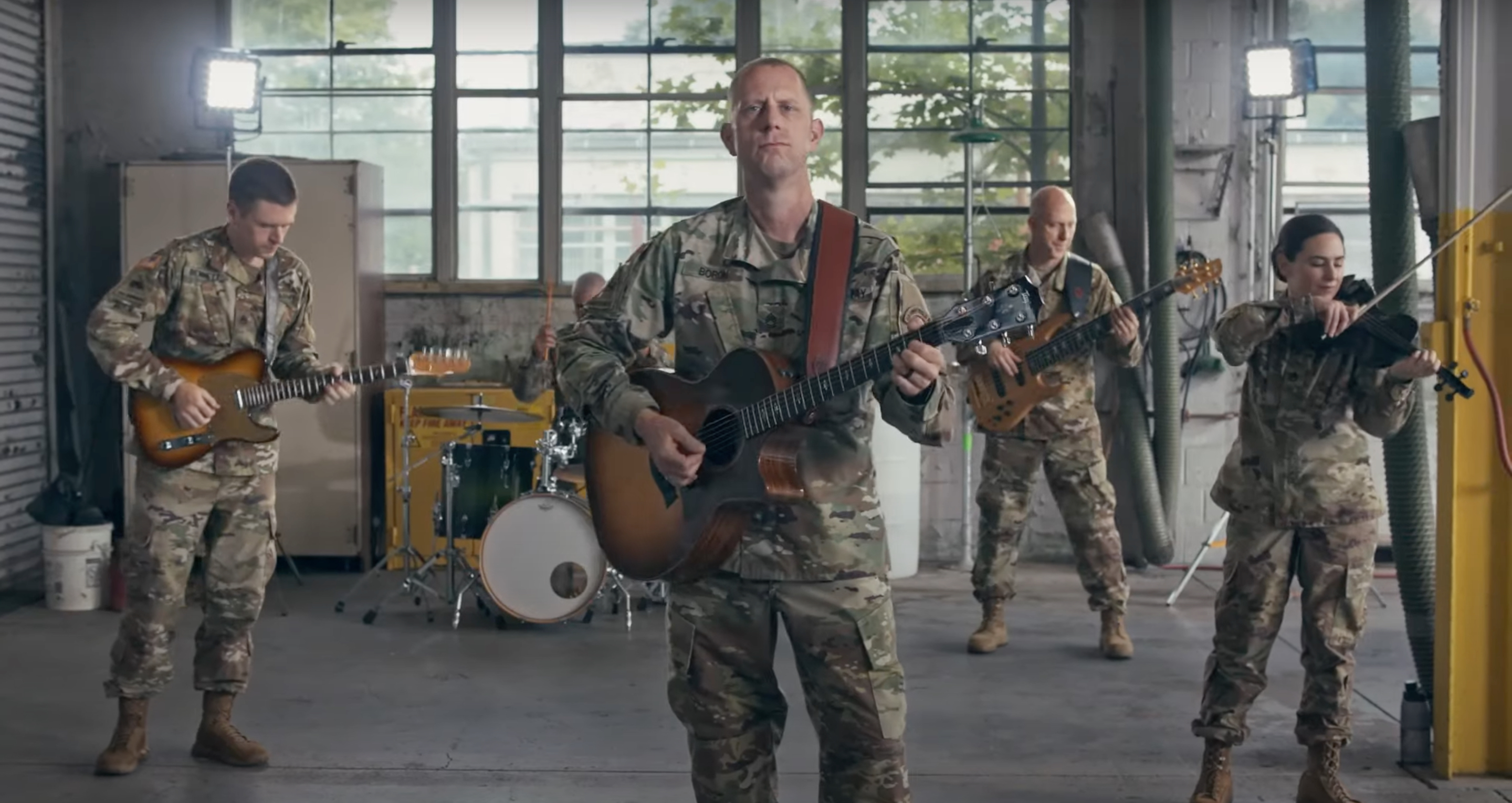AUSTIN, Texas — It’s 2 p.m. at the Department of Defense’s South By Southwest pop-up, and the bartender is looking at her phone. A handful of festival attendees mingle with military contractors nearby, but the sparse attendance feels even sparser in a 5,800-sq. ft. event space. The bartender tells me that I’m her first customer of the day. She hands me a beer, then the bill—despite the military’s $1.1 billion marketing budget, this is a cash bar.
SXSW is a 10-day tech, film, and music conference in Austin, Texas, that draws over 300,000 people and essentially takes over every venue in the city. Tech companies throw launch parties (Twitter in 2007), music careers take flight (Leon Bridges in 2015) and movie premieres draw thousand-deep lines outside the Paramount Theatre (this year’s big one was, maybe fittingly, Civil War). The event has been occurring in some capacity since 1987, and I’ve been attending as a performer, music journalist, and appreciator of free drinks since 2003. I have RSVPed for many cheesy corporate SXSW parties in my day, but this is the first time I’ve been handed a water bottle featuring the logo of the U.S. Army, one of this year’s festival’s six “super sponsors.”
SXSW booked nearly 1,200 bands for the 2024 event. Some of them were not happy about this military patronage at any time, let alone while we’re funding and sending weapons to be used in the ongoing genocide in Gaza. (Raytheon, Collins Aerospace and BAE Systems, who sell arms to the IDF, also had presences at the conference.) A week before the festival began, Boston indie rocker Squirrel Flower canceled her official festival shows. At least 75 other bands followed, including all 12 Irish acts (Kneecap were one of the buzziest to drop). Someone flashed the woke bat signal into the windows of the Governor’s Mansion and Greg Abbott tweeted good riddance to those bands. SXSW clapped back with a 185-word Twitter thread that disagreed with Abbott’s stance, but ultimately translated to “All Tech Matters.”
“The defense industry has historically been a proving ground for many of the systems we rely on today. These institutions are often leaders in emerging technologies, and we believe it’s better to understand how their approach will impact our lives,” read part of SXSW’s statement.
The Army sponsorship became this year’s big controversy (after band pay rates in 2023, which were raised by $100 in 2024). Of the 60 bands I saw, probably five of them made statements on stage about the military involvement. Other than that virtue banter, you could easily go through the full festival without noticing any of the Army’s marketing (they were notably the only super sponsor without their logo on the step-and-repeats). Or you could do what I did, and hang out at the military’s pop-up activation for a couple days and see what the Army was hoping to accomplish.
Austin is often considered a liberal outlier within Texas, a blue bubble that incubates startups and birthed the most consistent rock band of the last 30 years (I don’t even need to tell you it’s Spoon). But it is also the capital of the state’s very conservative government, which employs over 185,000 people in Austin as of 2021, including 800 active-duty military personnel at Camp Mabry.
The government and tech industry come together in camouflaged synergy at Army Futures Command. Headquartered in Austin, the military bills it as their innovation lab. It has 600 local staff members and 1,800 indirect employees. The contractors I spoke to made the Futures Command sounds like a Willy Wonka tech factory. According to the Futures Command website, they are working on six flavors of candy: long-range weapons, next-generation combat vehicles, future vertical lift tech, air and missile defense, a tactical network, and “soldier lethality.”

The Army Futures Command has actually been involved in the festival in some capacity since 2018, but no one seemed to notice until the rest of the Army showed up this year. So, for what it’s worth, there are actually some local ties that explain the Army’s sponsorship. But you could say the same about fellow super sponsor, C4 energy drink, which replaced White Claw as the festival’s only beverage sponsor.
Over the course of five days, there were 28 events on the SXSW Schedule tagged “Presented by: U.S. Army.” This ranged from your typical tech conference mumbo-jumbo (“Humanoids or Augmented Humans: Accelerating Autonomy with AI”) to a live “BattleBots Metal Mayhem” smackdown. Every day featured 7 a.m. workouts like “Yoga in Formation: Army-Inspired Mind and Body Balance at Brush Square Park.”
The Army’s SXSW headquarters for the week was a prime piece of real estate: an event space at 8th and Congress, just a couple blocks from the city’s main bar strip. On the SXSW schedule, the activation is called “This Is Our House (presented by Department of Defense Joint Innovation Organizations).” The venue itself normally rents for between $15-$20k per day, although the army probably only paid half that because at night the space hosted concerts by Spin Magazine, which declined to comment on their involvement, but did end one panel on music PR with a performance from a military band.
When you enter This Is Our House, you spin a wheel to win a prize. One day I won the water bottle; the second day, a 45 from a band called Six-String Soldiers (A side: “The Uniform,” B side: “Unsung Heroes”). Fellow youths, the Army is into vinyl too!
Somewhat inexplicably, there were a bunch of computers where 20-somethings were playing Rocket League. Somewhat more explicably, there were Quest headsets with tank gunner simulations. Members of the Golden Knights Parachute Team gave me a Meta Quest 3D VR experience of parachuting into a military base just as the edible was kicking in.
I had a conversation with a contractor about a Class 3 TRV-150 drone displayed on a pedestal. He explained that it could carry a max payload of 150 pounds a distance of eight kilometers at a cruising speed of 56 mph. I asked him what sort of context these were used in, and he described soldiers on remote missions far from their base. He said the drones usually deliver humanitarian aid. I asked what else. He asked: What would I want if I were stranded away from base? I said, in all honesty, that I’d probably want a gun.
South by Southwest’s sponsorship rates are not publicly available, and neither the Department of Defense nor SXSW responded to financial questions. An old deck states that the super sponsor can expect $1.5 million in marketing impressions for a fraction of the cost, which is not particularly helpful but does sound like a great deal. Trade show booths alone cost up to $135,000 in 2020; branding on napkins started at $20k. Based on estimates from veteran event planners, This Is Our House would’ve cost a non-affiliated festival brand maybe half a million dollars. A few blocks away, the Austin for Palestine Coalition spent about $300 on a protest show with what might’ve been the hottest lineup of the week.

Before the Army sponsorship backlash, AFPC secured a permit to host protests outside city hall. Tension started to build in late February with an Instagram post from AFPC that parodied SXSW’s logo by adding blood-streaked fighter jets. The organization demanded that SXSW disinvite Raytheon & Pals. SXSW fired off a cease and desist, and AFPC’s Instagram account was banned for a couple days.
Once bands began dropping out of the fest, the protest organizers started sending DMs. Suddenly AFPC’s Thursday day party was stacked. Squirrel Flower was playing, plus a lot of hyped festival dropouts like Enola Gay, They Are Gutting A Body of Water, and Tomato Flower. A cynic might say that a band foregoing a SXSW paycheck isn’t a particularly grand statement. But it’s a measly payday ($350 for bands, $150 for solo artists), and they ended up performing for the same audience just a few blocks down the street. The organizers of the protest concert see it in broader terms.
“I think we need to draw a line between entertainment and culture,” said Paul Biggar of Tech for Palestine. “Culture is what really brings communities together. Culture is what a lot of these artists came for. They have talent, they make music, and it’s fun and entertaining to listen to, but are they making it because somebody can make money off of it? That’s the entertainment industry.”
The boycott may not have made a dent in SXSW’s bottom line, but it did appear to have a significant local effect. The revenue from the 10 days of SXSW buoys businesses through the off season. The rash of cancellations left some iconic venues like Hotel Vegas scrambling to put together a lineup for what’s supposed to be the busiest week of the year. A massive corporate entity like SXSW isn’t exactly a magnet for sympathy, but it’s hard not to feel for a small concert venue hit with cancellations during the busiest week of its year.
“This is what boycotts are for,” said Cliff Clive of the Falasteen Street Museum. “They’re for making people realize that we’re all in the same system, we’re all in this together, and we are not required to take part in your capitalism that you’re doing—which is the same thing that’s killing people in Gaza.”
Back at the This Is Our House House, Pearl Snap pilsner in hand, I was enjoying one of the most impregnable bastions of capitalism: the trade show.
This wasn’t SXSW’s main massive convention-center trade show, rather just an event space with a handful of booths staffed by bored-looking military contractors who seemed incapable of imagining the offensive uses of their technology. Their drones definitely only delivered food. The lone wolf Rambo-types using power generators the size of my Fjallraven man-purse definitely only go on humanitarian missions. Even the 3D-printed scopes for mortars — designed in collaboration with soldiers via the Civil-Military Innovation Institute — were created to make these weapons safer for our troops to use, not more lethal for whoever’s on the receiving end. I understand SXSW’s “commitment to bring forward ideas that shape our world,” as they wrote in their statement, but the distance between world-shaping and killing tools is very, very small here, and everyone seemed blissfully unaware of it.
The cringiest moments came during a presentation, “From Movies to the Military: Designing Spatial Interfaces with MX Technology.” It was hosted by Hollywood special effects guy Jayse Hansen and Army Research Laboratory scientist Dr. Jeff Hansberger. Hansen has a cool job—he created the heads-up displays in Iron Man and Top Gun: Maverick, among others. He still works on movies, but now also contracts for the government, designing HUDs for tank operators.

Given the desperate state of the special effects industry, I could see how a cushy military contract would be appealing. But have a little shame. Hansen used the phrase “killer app” several times without a hint of self-awareness. About 30 minutes into the presentation, Hansen started explaining his tank gunner HUDs with a bit of creative jargon.
“I see this as an example of telling a story to the reverse, because you’re seeing not only what the current levels of your vehicles are, you’re seeing the entire past on the right hand side with the little graph, and you’re also being alerted to potential futures,” Hansen said. You see, by designing targeting systems for the military, he is in fact storytelling.
After attending SXSW for 20 years, I feel like I’ve got a good handle on the past and present, and can make some informed guesses about the future.
Despite my hand-wringing about the Army pop-up, I still love the festival. We’re talking about 1,200 bands here! I may not be cool enough anymore to have heard of most of them, but that’s the point. If you are interested in discovering new music—specifically international bands—there is nothing else like it. Add in the filmmakers and the smart-but-a-little-bit-terrible tech people and the 10 days of SXSW might be one of the highest concentrations of culture on the planet. The problem is that it’s also the highest concentration of entertainment, and therefore of advertising dollars.
For this ecosystem of a thousand concerts to continue to operate, it needs to be fed money. SXSW already sold half the company to Penske Media (owners of Rolling Stone) a couple years ago in what SXSW’s CEO called “a lifeline.” If they’re still so desperate for funding that they’d turn to the military, that’s not a good financial sign.
Most longtime attendees will tell you that the festival has shrunk in almost every way, and that really boils down to the marketing spends. The culture is still there, it’s just no longer served up in buffet form—the unofficial free/sponsored megaparties are a thing of the past. The Army installation made me long for the kinder, gentler days of festival marketing, when brands like HBO turned a whole ghost town into immersive theater, to advertise Westworld (there were no guns at that one). At the door they gave out white or black hats based on whether you wanted to play a good or evil character. At the Army activation, according to the folks there, there wasn’t a black hat in the house.
SXSW did not respond to questions about whether this is a multi-year contract, but if it is, that could have disastrous consequences for 2025’s bookings. Ultimately the future of SXSW doesn’t have much to do with Israel and everything to do with image. The average band definitely doesn’t play SXSW for the money, or even because it’s fun—they do it because it’s cool to play at SXSW. Sure, a lot of people attend the conference to network or because their companies buy them badges, but again, ultimately, they go because they think it’s cool. I go to this festival because I think seeing 60 bands in a week is cool. All love to the Six-String Soldiers, but it’s impossibly hard to make the Army seem cool.






